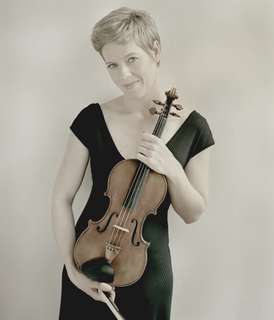|
Back
An Innate Gift New York
Walter Reade Theatre
08/08/2010 -
Ludwig van Beethoven: Violin Sonata No. 4 in A minor, Opus 23
Ferruccio Busoni: Violin Sonata No. 2 in E minor, Opus 36a
Isabelle Faust (Violin), Alexander Melnikov (Piano)

I. Faust (© Felix Broede)
If one must steal, then steal from the richest. The New Yorker’s Alex Ross is New York’s most richly gifted writer on music, and his description of Isabelle Faust’s Stradivarius violin was described in eloquent detail in last week’s issue. This, the “Sleeping Beauty” Strad was made around 1704, according to Ross, bought by a German noble family, who kept it in their family for a few centuries. The family, a descendant of whom was part of the plot to kill Hitler, then put the priceless Strad in a vault, it was tracked down by a violin dealer, and finally loaned to one of Germany’s most distinguished young violinists, Isabelle Faust.
Unlike Goethe’s doomed philosopher. Isabelle Faust is relatively youthful; at 38, she has retained that youthful, bright, agile musical personality, and obviously the Cremona-built tool to make it radiate.
While I would love to continue the analogy with a reference to Mephistophelean demonic tone, this is hardly her style. At times her bow hardly struck the strings, for neither the Beethoven nor the Busoni was made into a showpiece. Ms. Faust’s musicianship is more modest. Never the exhibitionist, her personality was as modest as her fingers were deft.
At first, this was rather unnerving. The Beethoven Fourth A minor sonata can be played with fiery energy, and yes, that demonic streak. It doesn’t have a single measure showing Beethoven’s supposedly grouchy temperament. With Ms. Faust, it became soufflé-light, almost Haydnesque
Part of this may been the early part of the first movement where Ms. Faust’s violin was barely heard in the octave measures with pianist Alexander Melnikov. The venue was not a concert hall, but the pianissimo marks were ultra soft. Soon, though, Ms. Faust became her own artist, the two performed with delicious, if hardly grand moments.
Those waiting for a Mutter-like vibrato and glorious line, must have been disappointed. Her touch was feathery, she never used excessive vibrato, and rarely was demonstrative. This was not detached playing at all, but artistry which seemed to gauge this early Beethoven as a whimsical youngster
Coincidentally, on my subway trip home, I had been reading H.L. Mencken on Beethoven, and he states that “even the lightest Beethoven has the dignity of the ancient prophets.” Mencken is one of America’s great essayists, but his fixation on German composers sometimes is outrageous. With Ms. Faust, the Fourth Sonata was less “prophetic” than Puckish.
If Haydn is witty. Beethoven, under these 20 fingers, was slapstick, the outbursts, the stops and starts of the finale having the nuances of burlesque comics. Our Prophet-Prometheus got off off his edifice, going out for a beer and a few jokes with the lads.
That could never be said for the second work, Busoni’s mighty, actually Promethean Second Violin Sonata. Busoni himself called it his “Opus 1”, since it was the first piece the virtuoso felt proud of. And indeed, one never feels its 32-minute length. It soars at times, the invention is ever-present, and the last-movement variations on a Bach chorale could easily rival Brahms’ own variations.

A. Melnikov (© Marco Borggreve)
Alexander Melnikov is an admirable pianist, his rapport with Ms. Faust ineluctable. The Busoni demands enormous power, and Mr. Melnikov had it to spare. But Busoni was hardly an anhedonic composer. The work is filled with the same tarantella-like dances which adorn his Piano Concerto, with Messrs Faust and Melnikov dancing through them.
That finale, based on the simple chorale from the Anna Magdalena Bach Notebook, Wie wohl ist mir (“How happy I am”) showed both performers at their happiest. The variations were sensuous, played without the conscious restriction of the variation form yet never free-wheeling. Rather, these two showed that innate musicianship, while not a crowd-wower (they gave no encores) can be a more memorable experience than mere technical theatricality.
Harry Rolnick
|